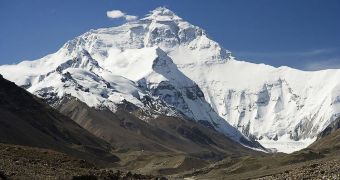The Himalaya mountain range is undoubtedly the most impressive in the world, even if only for the fact that it contains the six tallest massifs in the world. Notable among these is Mount Everest which, at its 8,848 meters (29,029 feet), exceeds any other mountain in the world. But the range itself was formed following the violent collision of the Indian and Asian tectonic plates. Now, researchers look at what went on underground when this happened, given that the above-ground results are fairly obvious. It was thus that a research team learned that the subduction process which takes place there pushed the Indian plate no less than 250 kilometers (155 miles) beneath the surface.
This is an impressive depth for such a collision, geologists say. Earth's tectonic plates lie on top of an ocean of molten rock, or magma, called the mantle. The mantle itself sits above the planet's solid, iron core, which spins. This makes the mantle move as well, and the plates also move on top of the mantle, driven by what could best be described as convection currents. At some locations, such as the mid-Atlantic ridge, the plates are pushed away from each other, generating new land mass, while at others (most notably the Pacific Ring of Fire and the India-Asia boundary) they are pushed against each other.
“The subduction of continental crust to this depth has never been reported in the Himalayas and is also extremely rare in the rest of world,” explains scientist Anju Pandey, who holds an appointment at the Southampton, England-based National Oceanography Center. He is also the coauthor of a new investigation detailing the findings, which appears in the May issue of the esteemed scientific publication Geology. The Indian plate first started colliding with Asia some 90 million years ago, and has continued to do so ever since. The Himalaya range is a direct product of the forces at work underground, which pushed the ground up to great heights.
“Our findings are significant because researchers have disagreed about the depth of subduction of the Indian plate beneath Asia. Our results are backed up by computer modeling and will radically improve our understanding of the subduction of the Indian continental crust beneath the Himalayas,” Pandey adds. The simulations are derived from an important discovery made at the collision site. Researchers found a mineral dubbed majorite, which is formed only under high pressure at high depth. Over eons, it is pulled to surface, where it releases oxygen. By analyzing its composition, researchers can easily determine when and at what depth it was formed, LiveScience reports

 14 DAY TRIAL //
14 DAY TRIAL //